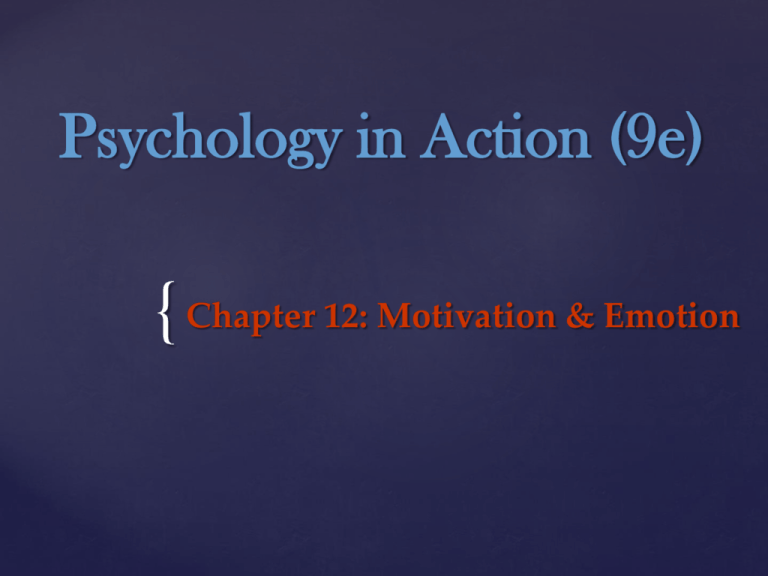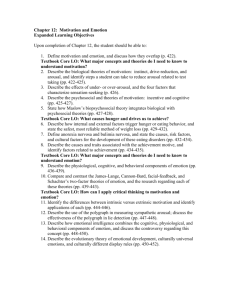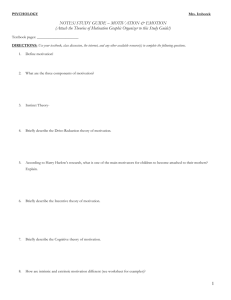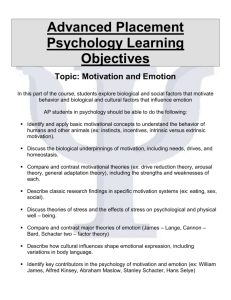Psychology in Action (9e) by Karen Huffman
advertisement

Psychology in Action (9e)
{ Chapter 12: Motivation & Emotion
Theories & Concepts of Motivation:
Important Definitions
Motivation: set of factors that
activate, direct, & maintain
behavior, usually toward some goal
Emotion: subjective feeling
including arousal, cognitions, &
expressions
Six Major Theories of Motivation
Major Theories of Motivation—
Biological Theories
Instinct: inborn, unlearned
behaviors universal to
species explain motivation
Drive-Reduction: internal tensions
“push” toward satisfying basic
needs
Arousal: motivated toward
optimal level of arousal
Instinct Theory
Drive-Reduction Theory
Arousal Theory
•
People seek an
optimal level of
arousal that
maximizes their
performance.
Major Theories of Motivation—
Psychosocial Theories
Incentive: motivation
results from the “pull”
of external
environmental stimuli
Cognitive: motivation
affected by attributions
& expectations
Biopsychosocial Theories
Maslow’s Hierarchy of
Needs: interaction of
biological, psychological, &
social needs; lower motives
(physiological & safety)
must be met before higher
needs (belonging, selfesteem)
Maslow’s Hierarchy of Needs
Motivation & Behavior:
Hunger & Eating
Biological factors:
stomach, biochemistry,
the brain
Note the size
difference in these rats.
The rat on the left had
the ventromedial area of
its hypothalamus
destroyed.
Motivation & Behavior:
Hunger & Eating
Psychological
factors: visual cues,
cultural conditioning
Obesity is more common
in Pima Indians living in
U.S., but not for those in
nearby Mexico with
traditional diet.
Hunger & Eating--Eating Disorders
•
Obesity appears to result from numerous
biological & psychosocial factors.
•
Anorexia nervosa & bulimia nervosa are
both characterized by an overwhelming
fear of becoming obese & explained by
multiple biological & psychosocial
factors.
Critical Thinking About
Motivation & Emotion
Intrinsic versus extrinsic motivation-extrinsic rewards may lower interest & motivation.
Motivation & Behavior—
Achievement
•
–
–
–
–
–
–
Characteristics of a high need for
achievement (nAch):
Prefers moderately difficult tasks
Prefers clear goals with competent
feedback
Competitive
Prefers responsibility
Persistent
More accomplished
Theories & Concepts of Emotion
1.
Three Components of
Emotions
Physiological-arousal comes from
brain (particularly
the limbic system)
& autonomic nervous
system
(ANS)
Theories & Concepts of Emotion
Mirror Neurons: brain cells
that fire both when performing
specific actions and when
observing specific actions or
emotions of another; this
“mirroring” may explain
empathy, imitation, language, etc.
Physiological Component & the
Autonomic Nervous System (ANS)
Theories & Concepts of Emotion
Three Components of Emotion (Cont’d)
2.
Cognitive--thoughts, values,
expectations
Behavioral--expressions,
gestures, & body positions
3.
&
Can you identify the social smile vs. the genuine
smile?
Real smiles involve muscles around both the eyes
& cheeks.
Theories & Concepts of Emotion-Four Theories of Emotion
James-Lange: subjective experience of
emotion follows bodily arousal
Cannon-Bard: arousal & emotion occur
simultaneously
Facial-Feedback: facial movements elicit
arousal & specific emotions
Schachter’s Two-Factor: arousal & label
(or interpretation) produce emotion
Critical Thinking About Motivation &
Emotion: The Polygraph
Polygraph: measures
changes in
sympathetic arousal,
which in turn
supposedly reflects
lying versus
truthfulness
Critical Thinking about Motivation
& Emotion: The Polygraph
The subject’s response on
the GSR does rise in
response to the second
question. But remember
that error rates on the
polygraph range from
25% to 75%.
Critical Thinking About Motivation &
Emotion: Emotional Intelligence (EI)
Emotional
Intelligence (EI):
ability to know &
manage one’s
emotions,
empathize, &
maintain satisfying
relationships
Culture, Evolution, & Emotion
Cultural similarities &
differences: 7 to10 culturally
universal emotions, but each
culture has its own display rules
governing how, when, & where to
express emotions
Role of evolution: strong
biological, evolutionary basis for
emotional expression & decoding
Plutchik’s Wheel of Emotions








